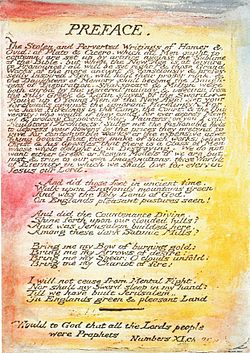Text
The poem is divided into two "books".
Book I opens with an epic invocation to the muses, drawing on the classical models of Homer and Virgil, which were also used by John Milton in Paradise Lost . However, Blake describes inspiration in bodily terms, vitalising the nerves of his arm. Blake goes on to describe the activities of Los, one of his mythological characters, who creates a complex universe from within which other Blakean characters debate the actions of Satan. As with all of Blake's Prophecies, the general structure of the Poem begins with the Fall and ends with the Apocalypse or consummation. The fall is pictured vividly as each of the five senses plummets into an abyss; each "broods" there in fear and desperation. These represent an early fallen Age in Blake's Mythological construct.
The early pages are dominated by a "Bard's Prophetic Song", heard in Heaven by the "unfallen" Milton. The relationship The Bard's Song has with the rest of the text is in dispute, and the meaning of it is complex. Referring to the doctrines of Calvinism, Blake's "Bard" asserts that humanity is divided into the "Elect", the "Reprobate" and the "Redeemed". Inverting Calvinist values, Blake insists that the "Reprobate" are the true believers, while the "Elect" are locked in narcissistic moralism. At this point Milton, hearing the Bard's song, appears and agrees to return to earth to purge the errors of his own Puritan imposture and go to "Eternal death".
Milton travels to Lambeth, taking in the form of a falling comet, and enters Blake's foot, [5] the foot here representing the point of contact between the human body and the exterior "vegetative world". Thus the ordinary world as perceived by the five senses is a sandal formed of "precious stones and gold" that he can now wear. Blake ties the sandal and, guided by Los, walks with it into the City of Art, inspired by the spirit of poetic creativity.
Book II finds Blake in the garden of his cottage, now Blake’s Cottage, in the village of Felpham. Ololon, a female figure linked to Milton, descends to meet him. Blake sees a skylark, which mutates into a twelve-year-old girl, who he thinks is one of his own muses. He invites her into his cottage to meet his wife. The girl states that she is actually looking for Milton. Milton then descends to meet with her, and in an apocalyptic scene he is eventually unified with the girl, who is identified as Ololon and becomes his own feminine aspect.
The poem concludes with a vision of a final union of living and dead, internal and external reality, and male and female, and a transformation of all of human perception.
Ololon: Blake studied Hebrew. He incorporated Hebrew twice in Milton and coined the name "Ololon" out of a Hebrew word. [6]
This page is based on this
Wikipedia article Text is available under the
CC BY-SA 4.0 license; additional terms may apply.
Images, videos and audio are available under their respective licenses.


